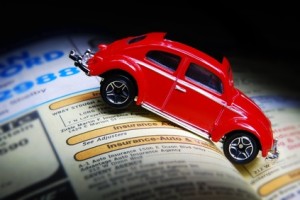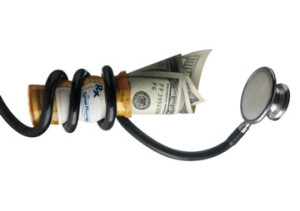February 8, 2014
 Every car insurance company promises you their very best rate. They also promise to make you an offer that their competition can’t top. In other words, insurance providers make promises they can’t keep. So, what can you do to make sure you get the best deal on the market? Make your own.
Every car insurance company promises you their very best rate. They also promise to make you an offer that their competition can’t top. In other words, insurance providers make promises they can’t keep. So, what can you do to make sure you get the best deal on the market? Make your own.
Consumers know that it pays to shop around. Smart buyers compare quotes from several insurers before purchasing a policy. However, even the savviest shoppers probably don’t know that after they’ve found the best coverage at the lowest rate there are ways to save even more.
How? It’s all about research. Car insurance companies will be quick to talk you into their most comprehensive coverage. On the surface, the old adage—more is better—appears to ring true. What these companies won’t tell you, though, is that these top-tier policies are excessive for everyday drivers. And in this case, excess is expensive. By taking a thorough look at your driving habits, vehicular assets, and overall financial situation, you can determine how much coverage you actually need.
Do you drive every day, or just occasionally? Is your commute 15 minutes, or 50? The answers to these questions matter. The more time you spend behind the wheel, the more likely you are to be involved in a collision, statistically speaking. Naturally, the converse is true. If you only net 15 road miles each week, you aren’t as likely to cash in on your policy. Many insurance representatives are trained to ask these questions when providing a quote. If yours never did, it’s time to make a phone call. And if you recently changed jobs and are now working closer to home, you should update your insurance provider; it’s likely that they will lower your rate.
What you drive matters just as much as how you drive. Unless your vehicle is new or you’re still making payments on an auto loan, you might be carrying more insurance than you need. Check the Kelley Blue Book value of your car. If this figure is significantly lower than your comprehensive or collision coverage, it may be time to adjust your policy accordingly. In some cases, as for those who drive old (but not collectible) cars, it could be worth dropping collision coverage entirely.
Choosing a plan with a higher deductible might not sound like a good way to save money. However, drivers with a great safety record can cash in big with this strategy. Here’s the logic: safe drivers are involved in fewer accidents. By raising your deductible, your insurance costs drop—sometimes an increase of just a few hundred dollars means a 15% to 40% reduction in overall policy fees. A portion of the money saved on premiums can be set aside to cover the deductible in the event you need to file a claim. The remainder of this money is then free for investment or can be put towards purchases you actually want to make.
Having your financial ducks in a row pays off. Many auto insurance providers will now review your credit score and reward fiscal responsibility with discounts. When you’re looking to spend less on car insurance, be sure to inventory your other expenses. Check for duplicate coverage. For example, AAA membership offers roadside assistance and towing. There’s no sense in carrying policy add-ons for these services if you’re already getting them elsewhere. This is also true for bodily coverage. If you carry a fairly comprehensive medical insurance policy, it is likely that any bills resulting from accident-related injuries will be taken care of.
Tags:
budgeting,
Car Finance,
Car insurance,
financial planning,
insurance,
investments
October 23, 2013
 Back when life insurance first came out, when it was common to have salesmen come knocking at the door, the odds of dying young were higher than they are now. Many illnesses that are treatable now were often fatal. Men, and women, were concerned with leaving their families with nothing and shouldering the burden of funeral costs on their own. Because of the advances in medicine, many of the illnesses that used to be fatal are now curable. With these advances, though, come the costs of treatment and care. That is why it is important for people of any age to look into no medical critical illness insurance.
Back when life insurance first came out, when it was common to have salesmen come knocking at the door, the odds of dying young were higher than they are now. Many illnesses that are treatable now were often fatal. Men, and women, were concerned with leaving their families with nothing and shouldering the burden of funeral costs on their own. Because of the advances in medicine, many of the illnesses that used to be fatal are now curable. With these advances, though, come the costs of treatment and care. That is why it is important for people of any age to look into no medical critical illness insurance.
It is estimated that in 2013 alone, over 180,000 people will be diagnosed with cancer. Over 46% of men and 41% of women may develop cancer sometime in their lifetime, and while the number of new cancer cases per year increase, and the odds of having cancer have gone up. So to, have the odds of surviving. Breast cancer, for example, has seen a decrease in death rates by 42% since 1986. So, while more people are being diagnosed with cancer, the odds of beating it (depending on the type of cancer) have gotten considerably better. Because of facts like this, rather than simply focusing on life insurance, getting a quote for no medical critical illness insurance should be a priority for everyone.
No medical critical illness insurance coverage takes care of the costs that may not be covered under healthcare or private plans. Costs such as: childcare, lost wages, travel costs, mortgage payments or other bills. This type of insurance pays out a lump sum upon diagnosis and survival that can be used to cover whatever shortfalls there are. With no medical critical illness coverage, there is no need to have a medical; therefore, everyone may qualify for coverage regardless of health.
While many illnesses such as cancer, stroke, or a heart attack may not happen to someone in their twenties, the best time to look at no medical critical illness insurance is before issues come up. Critical illness insurance will not cover pre existing conditions, so by purchasing coverage when in good health and young you will have coverage for future illnesses and save money as well. When purchased earlier in life, rates tend to cheaper as the odds of having illness occur are lower at that time.
Being diagnosed with cancer no longer means dying from it. Every day more and more people are surviving illnesses once thought incurable. With over 87% of the Canadian populace expected to be diagnosed with cancer at least once within their lifetime, it is important to think about getting a free no medical critical illness insurance quote as soon as possible.
NoMedicalLifeInsurance.ca is an initiative of independent insurance expert Tamara Humphries and LSM Insurance. They have unique expertise in finding the best possible rate for no medical critical illness insurance their team has access to and uses the most up-to-date financial planning software from their insurance carrier partners. They focus on preparing the best possible package for each client’s specific situation and needs.
Tags:
Claims,
Coverage,
Health Insurance,
insurance,
investment,
life insurance,
money
September 21, 2013
 In a perfect world, investments would constantly go up at a predictable and measurable rate, unaffected by variables or unwanted outside influences. Unfortunately, though, the world is far from perfect and the actual volatility of a financial asset or investment is subject to a myriad of influences. Some are welcome, some not so, but one thing is certain, over time the value of an investment such as a piece of jewellery or a fine work of art will change. This in turn will have a direct bearing on the type of insurance you will need to take out to protect that asset – and how much it will cost you.
In a perfect world, investments would constantly go up at a predictable and measurable rate, unaffected by variables or unwanted outside influences. Unfortunately, though, the world is far from perfect and the actual volatility of a financial asset or investment is subject to a myriad of influences. Some are welcome, some not so, but one thing is certain, over time the value of an investment such as a piece of jewellery or a fine work of art will change. This in turn will have a direct bearing on the type of insurance you will need to take out to protect that asset – and how much it will cost you.
Educating clients about risk
For insurance brokers, there is now more of a need to educate clients about the risks involved in protecting their assets. Charles Hamilton-Stubber of Aon Private Clients sums it up: “Investment volatility has meant families are placing more emphasis on protecting their tangible assets. In turn, the role of the insurance broker has become key to insulating wealth by educating and boosting understanding on tackling risks. As confidence has been lost in some elements of the financial services, insurance brokers are in a strong position to respond and offer effective advice on protecting wealth.”
What this translates as is that as we lose faith in perhaps what were seen as greater risk/return options before the financial crisis hit, the shift is more towards what are regarded as more ‘stable’ investments, such as fine art. For those who manage larger private insurance programmes (such as those with annual premiums in excess of £40,000 [or $66,000]), one of the best ways to risk assess is through the use of a ‘risk audit’.
Risk audits
Risk audits are a process of reviewing expenditure on insurance (which includes tangible assets such as property or fine art, liabilities and personal wellbeing), cross referencing them with their current insurance portfolio to find out if the existing arrangements are adequate and then finally offering practical solutions and advice in how to maximise coverage whilst minimising risk.
In recent years, the size and complexity of insurable assets amongst wealthier clients has changed. However, there may still be a disparity between the level of cover provided by existing insurance and the true worth of the assets. In addition, the increased risk to a client’s wellbeing (particularly if they travel extensively in what can be regarded as ‘high risk’ areas) could mean that their existing insurance is insufficient.
So it is up to the broker to ensure that their client is kept fully informed of the potential for their insurance to struggle to keep up with the volatility in value of an investment. It also needs to be pointed out to the client that there may be gaps or even overlaps in coverage, especially if policies have been taken out with different insurers. In this instance, the client could end up paying far more in premiums than they need to.
It’s also key to read the small print. While this may seem like generic advice, in some cases the wording of a policy may be outdated or even inappropriate for the risk being insured. Clarity is key, and so the overlying advice has to be to check those policies on a regular basis, especially if circumstances change, to ensure that they are current, offer the best coverage and that the client is actually getting what they’re paying for.
Tags:
Assets,
economy,
financial planning,
insurance,
investments,
money
August 28, 2013
 It will happen at a stoplight on your way to your first real job. The Plymouth Acclaim that you earned merely because you were the 16-year-old child of middle class suburbanites will not go, no matter how hard you hit the gas. The serpentine belt will blow, again, and it will seem silly to put more money into a car that is old enough to drink.
It will happen at a stoplight on your way to your first real job. The Plymouth Acclaim that you earned merely because you were the 16-year-old child of middle class suburbanites will not go, no matter how hard you hit the gas. The serpentine belt will blow, again, and it will seem silly to put more money into a car that is old enough to drink.
Still, what car seems affordable on an entry-level salary? Even the most economical of economy cars is likely too expensive to be paid for out-of-pocket. More often than not, securing an auto loan is a necessary step in purchasing your first car, and there are a few things that are helpful to know before you trust the offer made by your dealer.
New or Used?
Even before thinking about a loan, it is wise to decide whether you will purchase a new or used car, and from who? There are many pros and cons to both used and new cars, so it’s best to keep your budget in mind as you make your decision. Used cars, whether purchased as a “pre-owned” vehicle from a dealership or from your neighbor on Craigslist, will more often than not be significantly cheaper than a new version, and may not even be that, well, used. Notoriously, the value of a car depreciates as soon as it drives off the lot. If you buy a used car, make sure you have access to its entire history. Know who owned it before you. Know what accidents it has been involved in. That way, if you’re on the brink of having a used car horror story, you have the information to navigate your new-to-you car in another direction. On that note, never sign an As-Is statement. You are entitled to 30 days to find out whether the car is in working order.
As for new cars, they can be more expensive. And if few people are already driving that year or model, you can’t be absolutely sure that you haven’t landed yourself a lemon. Research is just as important with new cars as it is with used ones—you want to know the MSRP (Manufacturer Suggested Retail Price) and what deals other dealerships are offering on your chosen model. The Internet is a great place to research car prices, warranties, and safety features. Finance options for your new or used car can also be found online.
The Loan
Before you apply for a loan, it is wise to know your credit score first. There are many places that will give you access to your credit score for free online, such as Credit Karma. This will help you know what kind of interest rate for which you are eligible. Generally, the higher your credit score, the lower your rate. As you are young, it’s likely that your credit score will be low due to your brief credit history.
“The newer the car, the lower the rate” is also a piece of car finance advice that has been bandied about since the beginning of auto loans. While this may seem like a tick in the “pro” column for new vehicles, remember that the cost of the vehicle itself will likely be more than enough to make the savings in interest a moot point.
There are many ways for you to finance your car, and it’s smart to both diversify your application process and go to the dealer with a pre-approval already in place. Apply for loans at banks and credit unions, online financial institutions, and even the dealership (though these loans usually aren’t as competitive). Be honest on your applications, and take your time when considering all of your offers. Know the total cost of the loan. Pay attention to the loan term—a shorter term will involve higher monthly payments, but less interest. Don’t go for an offer that comes equipped with a laundry list of fees—you can be certain you won’t make up for the difference in savings on interest. No matter the case, do the math. Which offer works best with your current income? Which offer will allow you to save the most money in the long run?
If you go to the dealership pre-approved for a loan with a nice low rate, you will have the upper hand in negotiating what could be an even lower rate with you dealership.Be wary of the dealer offering you a lower price on the car with a higher interest rate. Remember, do the math. Rely on your own research. If you display clear confidence in your knowledge, it is less likely that the dealer financial manager will try to pull the wool over your eyes.
Driving Away in Your New…
While attempting to seduce you into their loan, the car dealership may offer you a number of “services” that also may not be in your best interest. Any “extended warranty” is more than likely not worth the extra cost—most warranties are extensive enough to cover any damages, and at the point the extension kicks in you will have spent more than you would out-of-pocket for repairs. Many dealerships offer expensive security systems that you could easily install yourself for less. Be careful about deciding to purchase life or disability insurance from your dealership. Like with loans, you may be better off getting a better deal elsewhere, if you need these types of insurance at all.
Of course, remember to have fun as you shop, and to buy a car that you can see yourself driving. A car may ultimately be a practical tool for transportation, but the right car can also provide a pleasurable experience.
Levi Hyatt is a part time blogger and a full time wannabe stunt driver. He’s carried his passion for cars over to writing about car financing. When he’s not going full throttle, Levi enjoys playing guitar for his cats George, Ringo and Paul.
Tags:
Assets,
Car,
Car Financing,
Car insurance,
economy,
insurance,
Interest Rates,
loans
July 15, 2013
 Most people know how important it is to have life insurance and to protect your assets, but an often overlooked aspect is protecting the most important asset you have – your income.
Most people know how important it is to have life insurance and to protect your assets, but an often overlooked aspect is protecting the most important asset you have – your income.
Most people heavily depend on their monthly income to provide for their family, pay off loan debts and keep up with other financial responsibilities.
The important thing to remember is that you can never know what could happen – and have to be prepared to handle your family’s financial situation if something were to go wrong.
Just ask yourself a few simple questions – what would you do if you’d become ill and wouldn’t be able to work for a few months? Would you still be able to provide sufficiently for your family?
A month or two may not seem like a lot of time – it could be a relatively minor mishap as a severe case of the flu or a broken leg, something that would keep you from working, and that could still have disastrous consequences on your family’s financial state.
What about an even worse scenario – if something was to happen to you and you wouldn’t be able to work again, either because of a permanent injury or death – how would you provide for your family?
Also, would you be able to set up your kids for their future – pay for their education?
Think about these questions and then it will become clear to you if you need health insurance. Basically, if you don’t have a really significant amount in savings and are dependent on your consistent income to meet all of your financial responsibilities, income protection is one of the most important things in making sure your family will be taken care of, no matter what.
There are plenty different plans you can choose from, but you should make sure that you got all the possible scenarios covered.
That includes short term income replacement – when you would be insured for the full or at least a significant amount of your monthly income and would be compensated for the period that you’d be unable to work.
You also need insurance in case something were to happen that makes you unable to work ever again – your family would have to be provided for, so insurance with a payout in the case of disability of death is also very important.
Finally, consider that not all expenses are direct – for instance, even if you wouldn’t consider your children’s education a regular expense, you still have to save money in order to provide for them, so you have to have an income protection plan that would cover the costs that will arise in the future – that, for instance, if something were to happen to you, your children would still get the proper education.
These are just a few examples of why income protection can be such a valuable asset – after all, in the year 2013 you can never be sure about your financial situation because of the still unstable economy, so protecting your family in as many ways as you can is critical.
Income protection is just another way of getting a little safer – this way you can create at least a few safety nets that will cushion the financial hit if something unexpected were to happen.
Romayne Warner is a full time self-employed blogging fanatic. Obsessed with finding small ways to save money every day, she enjoys sharing her frugal lifestyle tips and tricks with the world, she regularly writes about saving money.
Tags:
budgeting,
economy,
financial planning,
income,
insurance,
life insurance,
money
 Every car insurance company promises you their very best rate. They also promise to make you an offer that their competition can’t top. In other words, insurance providers make promises they can’t keep. So, what can you do to make sure you get the best deal on the market? Make your own.
Every car insurance company promises you their very best rate. They also promise to make you an offer that their competition can’t top. In other words, insurance providers make promises they can’t keep. So, what can you do to make sure you get the best deal on the market? Make your own.




Recent Comments